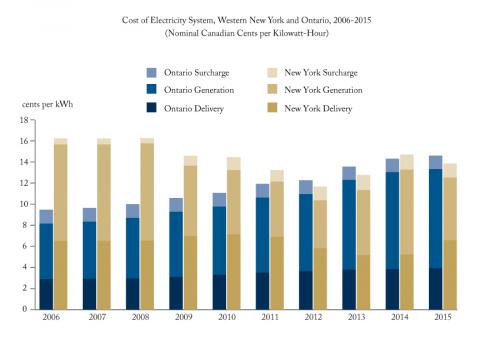From: Benjamin Dachis, Aaron Jacobs and Ramya Muthukumaran
To: The Hon. Minister Glenn Thibeault, Ontario Minister of Energy
Date: September 12th, 2016
Re: Why is Ontario’s Electricity Now More Expensive than its Neighbour’s?
This week’s throne speech focused on getting the cost of electricity down. It’s now your job to figure out how.
A comparison of Ontario prices to our neighbours in Western New York shows how large the problem is. The state’s electricity generation mix is similar to Ontario’s, with a large share from nuclear and hydroelectric power.
In 2006, electricity in Ontario was about 40 percent cheaper than New York. At the time, low electricity prices brought many businesses to the province. Today, that advantage has been lost: Ontario now has electricity prices that are 5 percent higher than New York’s.
It’s worth mentioning that these are the average costs. Many large industrial consumers pay much less. Smaller consumers – homeowners and small businesses – pay much more.
Overall, prices in Ontario grew by 54 percent from 2006 to 2015. In contrast, prices in New York fell by 16 percent (in Canadian dollar terms).
Why have Ontario’s prices increased? We break the cost of electricity into three main parts: generating electricity, delivering electricity to end users, and surcharges to operate and regulate the system (see Figure below).
The main cause of the spike in electricity prices in Ontario is the cost of generating electricity, which increased 78 percent from 2006 to 2015. Subsidies for low-emission energy and coal phase outs are the likely culprits. In contrast, generation costs fell by 37 percent over the same period in New York.
The cost of delivering electricity has also increased more in Ontario than in New York. Ontario’s long-distance transmission and local distribution cost consumers one-third more in 2015 than 2006, while prices were flat in New York.
The surcharges to operate the system are fairly small in both places, so the recent removal of one of the surcharges – the Debt Retirement Charge – in Ontario won’t do much to reduce prices.
Ontario’s electricity system is expensive, and fares poorly against the comparable region of Western New York. Keep in mind that New York has the 4th highest retail electricity price in the US. High and rising electricity prices are hurting the competitiveness of Ontario’s businesses. Reforming the wholesale electricity market, sticking with the sale of Hydro One, and finding efficiencies in delivering electricity would be the first steps towards improvement.
Note: We produced Ontario delivery prices using the total annual transmission revenues from Hydro One annual reports and total revenues from distribution services as reported by the Ontario Energy Board. Generation costs are the weighted annual sum of the Global Adjustment and the Hourly Ontario Electricity Price from the IESO. We produced Western New York prices by creating the weighted average of commercial, residential and industrial prices in Central and Western New York, weighted by the share of total New York consumption by consumer type.
Benjamin Dachis is an Associate Director of Research; Aaron Jacobs and Ramya Muthukumaran are Researchers at the C.D. Howe Institute.
To send a comment or leave feedback, email us at blog@cdhowe.org.






